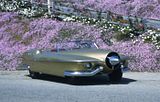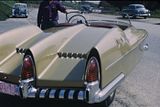Unseen for more than 60 years, the one-off Manta Ray will once again return to the spotlightDaniel Strohl, Hemmings Blog on Feb 8th, 2016 A half-century is a long time for a car to hide out, away from prying eyes and offers to buy it, even longer when that car looks like a jet engine on wheels and graced many of the hot rod and custom magazines of its day. Yet the Manta Ray of the early 1950s has remained unseen by the general public since before 1959, a 57-year absence that will end this spring. Like many other dreamers and creatives enamored with cars in the first half of the Fifties, Glen Hire and Vernon Antoine of Whittier, California, found their imaginations running wild after their first glimpses of Harley Earl’s 1951 XP-8 Le Sabre, one of two GM concept cars that would pave the way for GM’s Motoramas and dozens of other XP-designated concepts. Unlike most of those other dreamers, however, Hire and Antoine – both employed in aircraft design at North American at the time – decided to act on their dreams. They converted a backyard garage into a workshop, bought a 1951 Studebaker Commander to serve as the foundation for their project, and in 1952 began to transform the Studebaker into what they called the Manta Ray. Off came the stock body and on went a three-seater roadster body made entirely of fiberglass, one that Hire and Antoine infused with as many jet-age styling elements borrowed from their day jobs as they could fit onto a car. The nosecone they scratch-built by first making a wooden pattern and then casting a 1/4-inch shell. The fiberglass body they molded in 14 sections. And the triple taillamps they nabbed from a 1952 Lincoln. Underneath the fiberglass skin, they left the Studebaker 232-cu.in. V-8 and chassis stock save for chopping three inches in length from the frame rails. The finished Manta Ray featured in a number of car magazine articles in 1953 and 1954, among them one written for the February 1954 issue of Rod and Custom, in which Dean Moon notes that Hire and Antoine sold the Manta Ray to jet car builder Bob Yeakel. Hire and Antoine claimed they weren’t done with the Manta Ray just yet, though: With Yeakel’s permission, they intended to go into production with the Manta Ray, using their already developed molds to pop out more bodies that they intended to place on steel-tube chassis powered by Cadillac V-8s. “If we can get the car into some production, it was (worth the time and money to build it),” Antoine told Motor World for its June 1953 issue. “Otherwise, no!” Presumably Hire and Antoine never felt the Manta Ray was worth their time and money; no production versions of the Manta Ray followed. As for the original car, which fiberglass sports car researcher Geoff Hacker believes was completed and shown in late 1952 and thus debuted before the Chevrolet Corvette, by 1959 it somehow made its way out to a used car dealer in Topeka, Kansas, where collector L.L. “Peanuts” Lacer of Junction City, Kansas, first came across it. “Dad was a rare one,” Lacer’s son, D.E., said. “He was always buying weird old cars that nobody wanted, then never driving them.” Peanuts traded a Volkswagen and a Crosley for the Manta Ray, then brought it back to Junction City where he stuck it in a warehouse and then never touched it until the day he died in 1990. “If he bought a car with a dent in the fender, then it still had that dent in the fender when he died,” D.E. said. “The Manta Ray wasn’t really his cup of tea – he was more into European cars – so it was amazing he never sold it, but nobody else had one.” After Peanuts died, his widow, Darlene, began a slow process of liquidating the 120-car collection, but she reserved a handful of cars, including the Manta Ray, which D.E. had expressed an interest in. Over the last few years, D.E. has taken on the task of not only getting the Manta Ray running and driveable again, but also researching just what it was his father bought. With Hacker’s help, he’s been able to determine that a couple major changes were made to it in the years between Yeakel’s purchase of the car and its migration to Kansas. First, possibly related to Hire and Antoine’s production plans for the car, the Studebaker V-8 was swapped out for a dual-quad Cadillac V-8 of undetermined size. Second, somebody repainted it from its original gold to a pink. With some help from an automotive restoration student at McPherson College, D.E. has since cleaned up the Manta Ray, though he decided to leave it unrestored for the time being. “The day’s coming to put it back to gold, but that’s not anytime soon,” he said. “As it sits now, it’s just the way my dad got it – it still has the original tires.” He’s also committed it to the Amelia Island Concours d’Elegance – as part of the Concepts Beyond Detroit class – and to McPherson College’s annual car show, probably the only times he plans on showing it in the near future. Amelia Island will take place March 11-13, while McPherson’s show will take place April 29-30. For more information, visit AmeliaConcours.orgor McPherson.edu.
|
|





